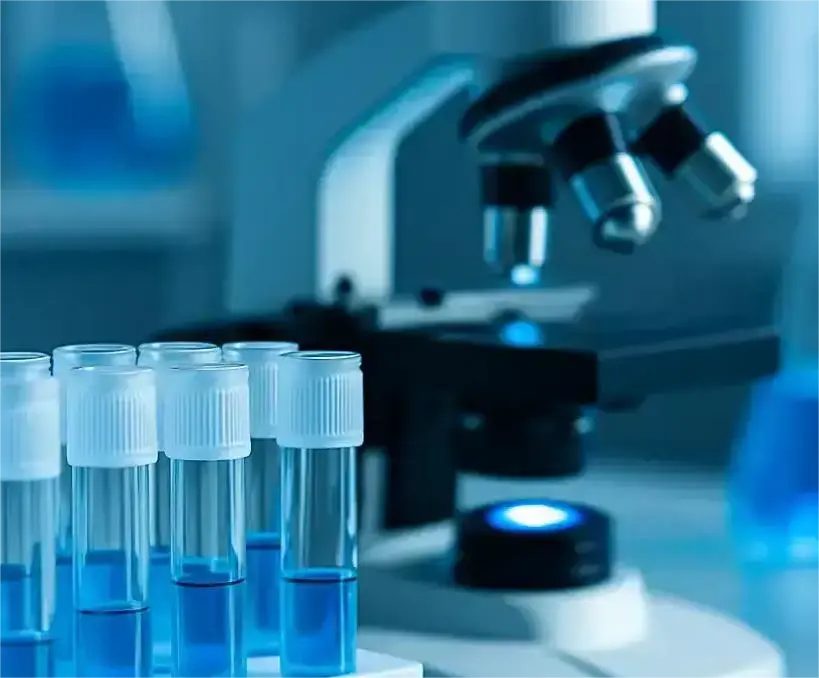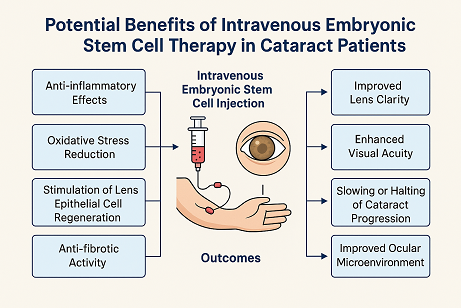Potential Benefits of Intravenous Embryonic Stem Cell Therapy in Cataract Patients: An Expert Overview

Cataract is a progressive ocular condition characterized by the opacification of the eye’s natural lens, leading to visual impairment and, in severe cases, blindness. The pathogenesis of cataract is multifactorial, involving oxidative stress, خلل في الميتوكوندريا, protein aggregation (primarily of crystallins), and cellular senescence of lens epithelial cells (LECs). Etiological factors include aging, diabetes mellitus, prolonged UV exposure, corticosteroid use, and certain genetic mutations.
Conventional treatment for cataracts is surgical extraction of the opacified lens followed by intraocular lens (IOL) implantation. لكن, this approach is purely mechanical and does not address the underlying cellular damage, nor does it prevent future degenerative changes in the remaining ocular tissues. هكذا, regenerative approaches, such as embryonic stem cell (خروج) مُعَالَجَة, are being explored as potential alternatives or adjuncts.

Mechanism of Action of Embryonic Stem Cells in Cataract Pathophysiology
الخلايا الجذعية الجنينية (ESCS), derived from the inner cell mass of the blastocyst, are pluripotent and capable of differentiating into all three germ layers, including ocular cell lineages. When administered intravenously, ESCs exert their therapeutic effects primarily through إشارات باراكرين, systemic immunomodulation, and cellular replacement الآليات.
In the context of cataract, the key benefits of intravenous ESC therapy include:
- الآثار المضادة للالتهابات:
ESCs secrete cytokines and exosomes that modulate systemic and local inflammatory responses. Given that chronic inflammation and oxidative stress contribute significantly to LEC apoptosis and lens opacity, ESC-derived factors can mitigate these pathways. - Oxidative Stress Reduction:
ESCs enhance the endogenous antioxidant defenses by upregulating enzymes like superoxide dismutase (SOD), catalase, and glutathione peroxidase, thus protecting lens proteins from oxidative damage and aggregation. - Stimulation of Lens Epithelial Cell Regeneration:
ESCs may differentiate into lens-like cells or release growth factors such as fibroblast growth factor (FGF), عامل نمو خلايا الكبد (HGF), and insulin-like growth factor-1 (IGF-1), which support the regeneration and maintenance of LECs—essential for lens transparency. - Anti-fibrotic Activity:
By downregulating TGF-β signaling, ESCs can prevent epithelial-mesenchymal transition (EMT) of LECs, which is implicated in posterior capsule opacification (PCO)—a common postoperative complication of cataract surgery. - المناعة:
ESCs modulate immune cell activity and reduce systemic pro-inflammatory cytokines (على سبيل المثال, IL-6, TNF-α), which may contribute to a healthier ocular microenvironment conducive to tissue repair.
Clinical Outcomes and Expected Benefits
Although clinical data are still emerging, early observations and preclinical studies have reported the following outcomes post intravenous ESC therapy in cataract patients:
- Improved lens clarity in cases of early or non-nuclear cataracts, potentially delaying or eliminating the need for surgical intervention.
- Enhanced visual acuity, likely due to partial restoration of lens transparency and improved retinal signaling.
- Slowing or halting of cataract progression, especially in metabolically active lenses where oxidative damage can be reversed or mitigated.
- Improved ocular microenvironment, as a result of systemic anti-inflammatory and antioxidative effects.
- Better postoperative outcomes, if used as adjunctive therapy—ESCs may reduce inflammation and fibrosis post-surgery, minimizing complications like PCO.
خاتمة
Intravenous administration of embryonic stem cells offers a promising regenerative approach to address not only the symptoms but also the underlying causes of cataract formation. By targeting key pathogenic mechanisms—oxidative stress, اشتعال, and epithelial cell degeneration—ESC therapy has the potential to transform the management of cataracts from a purely surgical model to a biologically restorative one
